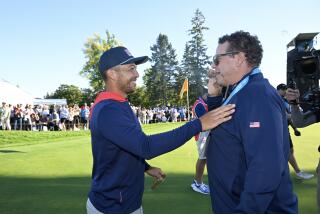AMERICA’S CUP : Il Moro Sails to a Victory : Yachting: Italian challenger is three-second winner when it lets out headsail to reach finish line first.
- Share via
SAN DIEGO — Like a sprinter leaning into the tape, Paul Cayard lunged Il Moro di Venezia’s billowing headsail straight toward the finish line, while Bill Koch’s America 3 strained from alongside.
Sunday’s was the closest finish in 28 America’s Cup finals over 141 years. The Italians won by three seconds to square the best-of-seven series at 1-1.
“I hope the public that were able to see it on TV all over the world enjoyed that race,” Cayard said. “They don’t get any finer than that.”
The previous closest was defender Weatherly’s 26-second victory over Australian challenger Gretel at Newport, R.I., in 1962.
Bruno Trouble, the French press officer for Louis Vuitton, sponsor of the challenger trials, was so thrilled he wrote in his race summary, “Today’s race will help sailing to become a major sport!”
Those who watched will settle for what it was: a classic match race between 75-foot boats sailed as aggressively as possible.
With the wind 10 knots, dropping to eight, it was lighter than in America 3’s 30-second victory over Il Moro in Race 1.
America 3 seemed faster Sunday, especially downwind. Il Moro caught a right-hand wind shift to go in front on the first leg, and the boats were never more than five or six lengths apart through the whole 20 nautical miles. Cayard never gave rival helmsman Buddy Melges an opportunity to pass.
The crews were tested physically by 22, 27 and 38 tacks on the three windward legs, and the helmsmen and tactician were pushed mentally by the tight maneuvering.
Early on the first leg, Cayard seemed relaxed, sitting on the rail rather than standing at the wheel, as he usually does, while Il Moro chief Raul Gardini, the 17th man on a boat on which 16 work, chain-smoked behind him.
But soon the action picked up, and Melges took his best shot at the lead when he ducked behind Il Moro’s stern, trying to steal the favored right side of the course. Cayard responded with a “slam-dunk”--quick--tack onto America 3’s wind. For a couple of minutes it seemed Melges had driven through to clear wind, but Cayard hung on him and eventually drove him back.
“(Cayard) did a masterful job of preventing it,” America 3 syndicate president Bill Koch said. “He may be the second-best sailor in the world.”
The best, Koch says, is still Dennis Conner. Melges, Koch says, is “good enough to be on America 3 and win the America’s Cup.”
America 3’s next chance came on the second leg, which was downwind. But when Melges pulled alongside to windward, Cayard, controlling the right of way, surprised him by suddenly luffing--turning--his boat sharply upwind, toward America 3, forcing the rival away in disarray and restoring Il Moro’s five-length lead.
Il Moro protested because, Cayard said, America 3’s flapping spinnaker brushed his backstay (the aft rigging that holds the mast up). The on-water umpires didn’t see it, so they couldn’t call it.
Koch said: “I don’t know. I wasn’t looking at, uh . . . I wasn’t in position to see it. What do you think, (Buddy)?”
Melges said: “I was turning the boat pretty hard about then, Bill, and I thought we were clear.”
With Koch steering only one of the ensuing legs, America 3 stayed within striking range and came at Il Moro again near the downwind finish. The difference may have been America 3’s final jibe toward the line, when its gennaker snagged a spreader on the mast and had to be lowered briefly, costing distance.
“We had the race won, except for that,” Koch said. “We’re gonna have jibing practice tomorrow.”
As they ghosted toward the line side by side, Cayard pushed his big red boat straight downwind inside the buoy and released the sheet to let his white gennaker blow farther out in front, like Carl Lewis’ chest.
“It was a great race,” Cayard said. “Hard work out there. I felt we gave ‘em some pretty hard shots on the run and with some slam dunks upwind. They hung tough. Looks like it’s gonna be a good, tough week.”
It was the first time a European entry had won a Cup match race since 1934, when T.O.M. Sopwith’s Endeavour from England beat Harold Vanderbilt’s Ranger before losing the series, 4-2.
Sticklers for detail will insist that Il Moro’s victory wasn’t the closest finish in Cup match history. They will point out that Sir Thomas Lipton’s Shamrock II, skippered by E.A. Sycamore, beat Charlie Barr’s Columbia by two seconds in 1901.
However, they sailed by time allowance in those days, and Columbia’s handicap gave it a 41-second victory.
Il Moro was involved in two one-second finishes with New Zealand this year, and Britain’s White Crusader beat Canada II by 26-hundredths of a second at Fremantle in 1986, but those were in trial races, not the Cup.
The ’62 race also featured a downwind finish with spinnakers. Skipper Bus Mosbacher faked out rival Jock Sturrock by dousing his spinnaker shortly before the finish, and when Sturrock also switched to a genoa Mosbacher quickly rehoisted his spinnaker and accelerated across in front.
Racing resumes Tuesday.
More to Read
Go beyond the scoreboard
Get the latest on L.A.'s teams in the daily Sports Report newsletter.
You may occasionally receive promotional content from the Los Angeles Times.






